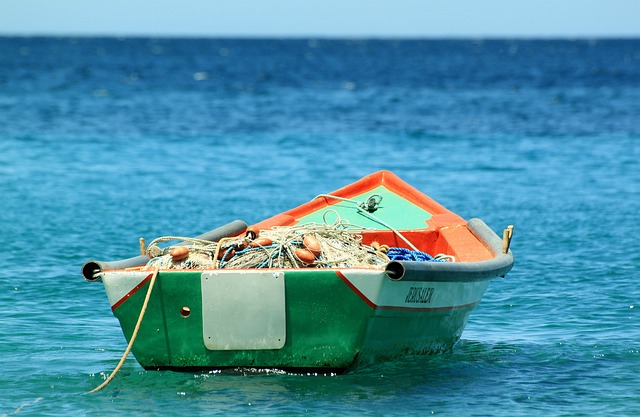Proper boat battery installation is critical for ensuring optimal performance, longevity, and safety of your vessel's electrical system. It involves securing the battery to minimize vibration and prevent internal damage or external hazards like short circuits. A detailed guide tailored for boat batteries is essential, as it covers selecting the right size, secure placement, and safe connections, including proper polarity and terminal usage to avoid corrosion and electrical issues. Safety measures such as using a battery box and ensuring adequate ventilation are non-negotiable to prevent gas accumulation. The guide also addresses integrating the battery with other onboard electronic devices for stable power supply. Choosing the right boat battery type—whether it's for starting or deep-cycle use—is important, considering the unique maritime conditions of moisture, salt, and temperature extremes. Preparation for installation includes having the necessary tools like hand tools, a multimeter, and safety gear. Post-installation, regular maintenance is crucial: check connections for tightness and corrosion, ensure proper charging practices to maintain battery health, top off electrolyte levels if needed, and store your boat in a cool, dry place to extend the battery's life. Adhering to these steps will guarantee that your marine electrical system operates efficiently and safely.
Embarking on a boating adventure or upgrading your vessel’s electrical system? A properly installed boat battery is paramount for powering your journey. This article delves into the critical aspects of boat battery installation, ensuring you select the right type and execute the process safely and effectively. With a comprehensive step-by-step guide tailored for marine batteries, coupled with essential tools and materials advice, extend your battery’s lifespan through post-installation checks and maintenance tips. Dive into the intricacies of boat battery installation to enhance your boating experience and safeguard your investment.
- Understanding the Importance of Proper Boat Battery Installation
- The Step-by-Step Guide to Installing a Boat Battery Safely and Effectively
- Selecting the Right Boat Battery Type for Your Vessel's Needs
- Tools and Materials Required for a Successful Boat Battery Installation
- Post-Installation Checks and Maintenance Tips to Extend Your Boat Battery's Lifespan
Understanding the Importance of Proper Boat Battery Installation

When it comes to ensuring your vessel’s electrical systems operate optimally, understanding the importance of proper boat battery installation cannot be overstated. A well-installed battery not only extends its lifespan but also maximizes its performance, which is crucial for both safety and convenience on the water. Proper installation involves a precise placement to minimize vibration that could lead to internal damage over time. It’s imperative to secure the battery in place to prevent movement that might cause short circuits or connections to loosen or break, potentially leading to dangerous situations. Additionally, correct installation ensures the battery is charged properly and maintains its charge longer, which is essential for multi-day trips where power becomes a premium. Safety precautions, such as using the correct type of battery box and proper ventilation to prevent gas accumulation, are also integral parts of this process. By adhering to a step-by-step guide tailored for boat batteries, you’re safeguarding your investment and ensuring that your marine electrical system is reliable, efficient, and safe for use under various conditions on the water.
The Step-by-Step Guide to Installing a Boat Battery Safely and Effectively

When installing a boat battery, adherence to a detailed and methodical approach is paramount for both safety and optimal functionality. A step-by-step guide serves as an invaluable resource, guiding you through each phase of the process with precision. This guide ensures that every connection is secure, every measurement is accurate, and every component is placed correctly within the vessel’s electrical system. Safety precautions are emphasized throughout, from selecting the appropriate battery size for your boat to properly securing it to prevent movement that could lead to damage or shorts during operation.
Moreover, the guide provides clear instructions on how to connect the battery to the boat’s electrical circuitry, including the correct polarity and proper use of terminals and cables to avoid corrosion or electrical issues. It also covers the essential steps for integrating the battery with other electronic devices on board, such as fish finders, GPS systems, and depth sounders, ensuring that each device operates at its best with a stable power supply. Following this guide step-by-step not only simplifies the installation process but also ensures that your boat’s electrical system is set up for longevity and peak performance, making every trip safer and more enjoyable.
Selecting the Right Boat Battery Type for Your Vessel's Needs

When it comes to outfitting your vessel with a battery that meets its unique needs, selecting the right boat battery type is paramount. A boat’s electrical system has distinct requirements compared to land-based applications due to the maritime environment’s challenges, such as exposure to moisture, salt, and temperature fluctuations. Boat batteries are specifically designed to handle these conditions, offering enhanced durability and performance. For starters, there are two main types of boat batteries: starting (cranking) batteries and deep-cycle batteries. Starting batteries are designed for short, high-current bursts needed to start the engine, while deep-cycle batteries are built for sustained power use, such as trolling equipment or running electronics. Depending on your vessel’s primary functions, you may need one type, or a combination of both. Additionally, it’s crucial to consider the battery’s capacity and amp-hour rating to ensure it aligns with your boat’s power consumption patterns. Factors like the size of your vessel, the electrical appliances on board, and whether you’re using your boat for trolling or long cruises will influence the type of battery best suited for your needs. Always refer to your boat’s manufacturer specifications and consult with a marine battery expert to make an informed decision that ensures your onboard systems run smoothly and reliably. By selecting the right boat battery, you can ensure that your vessel’s electrical system is ready to perform under any condition it may face at sea.
Tools and Materials Required for a Successful Boat Battery Installation

When planning to install a new boat battery, having the correct tools and materials on hand is crucial for a successful and efficient process. The first step involves gathering all necessary equipment, which includes basic hand tools such as wrenches, pliers, a screwdriver set, and a set of Allen keys. These will be used for removing hardware, securing the battery in place, and making any necessary connections. Additionally, you’ll need a multimeter to check the voltage and condition of the new battery before installation. Safety gear, including insulated gloves and safety glasses, is essential to protect yourself from electrical hazards and any potential sparks or debris.
For the battery itself, ensure that you select the correct type and size compatible with your boat’s make and model. The right marine battery will have the necessary capacity and reserve capacity for your boating needs, whether it’s for trolling or starting the engine. Alongside the battery, you’ll require a reliable battery holder or tray to support it securely in place. This holder should be non-conductive to prevent any electrical contact with metal surfaces. Other materials to consider are terminal cleaners and anti-corrosion spray to maintain optimal conductivity and lifespan of the connections. Finally, have marine-grade cable and connectors ready for making reliable battery connections, as well as a battery maintenance manual or guide that outlines specific instructions for your boat model. With all these tools and materials at the ready, you’ll be well-prepared to safely and effectively install your new boat battery.
Post-Installation Checks and Maintenance Tips to Extend Your Boat Battery's Lifespan

Following the installation of your boat battery, it is crucial to perform a series of checks to ensure optimal performance and longevity. Firstly, verify that all connections are secure and free from corrosion. Loose terminals can lead to poor electrical contact, which may cause reduced efficiency or even damage the battery or other components over time. Use a cleaner designed for battery terminals and apply a protective coating to prevent future corrosion.
Secondly, after installation, charge the battery fully and monitor its state of charge regularly. Keeping your boat battery charged appropriately is essential for maintaining its health. Avoid letting it discharge completely or overcharging it. Consistent maintenance, such as checking electrolyte levels if you have a lead-acid battery (and topping them off when necessary), cleaning terminals periodically, and ensuring that the ventilation around the battery is adequate, will help prevent issues like sulfation and overheating. Additionally, storing your boat in a cool, dry place can protect your battery from extreme temperatures that could shorten its lifespan. By adhering to these post-installation checks and maintenance tips, you can significantly extend the life of your boat battery and ensure it operates at peak efficiency for as long as possible.
When it comes to maintaining the functionality and longevity of your marine vessel, proper battery installation is key. This guide has outlined the critical steps to safely and effectively install a boat battery, ensuring optimal performance for your nautical adventures. By selecting the right type of boat battery for your vessel’s needs and utilizing the necessary tools and materials, you can avoid common pitfalls that might otherwise lead to reduced efficiency or premature battery failure. Additionally, the post-installation checks and maintenance tips provided are essential to extend your boat battery’s lifespan, ensuring many more outings on the water. Remember to follow these guidelines closely for a secure and well-functioning setup. With the right knowledge and approach, your boat’s battery installation will be a smooth and successful endeavor.
